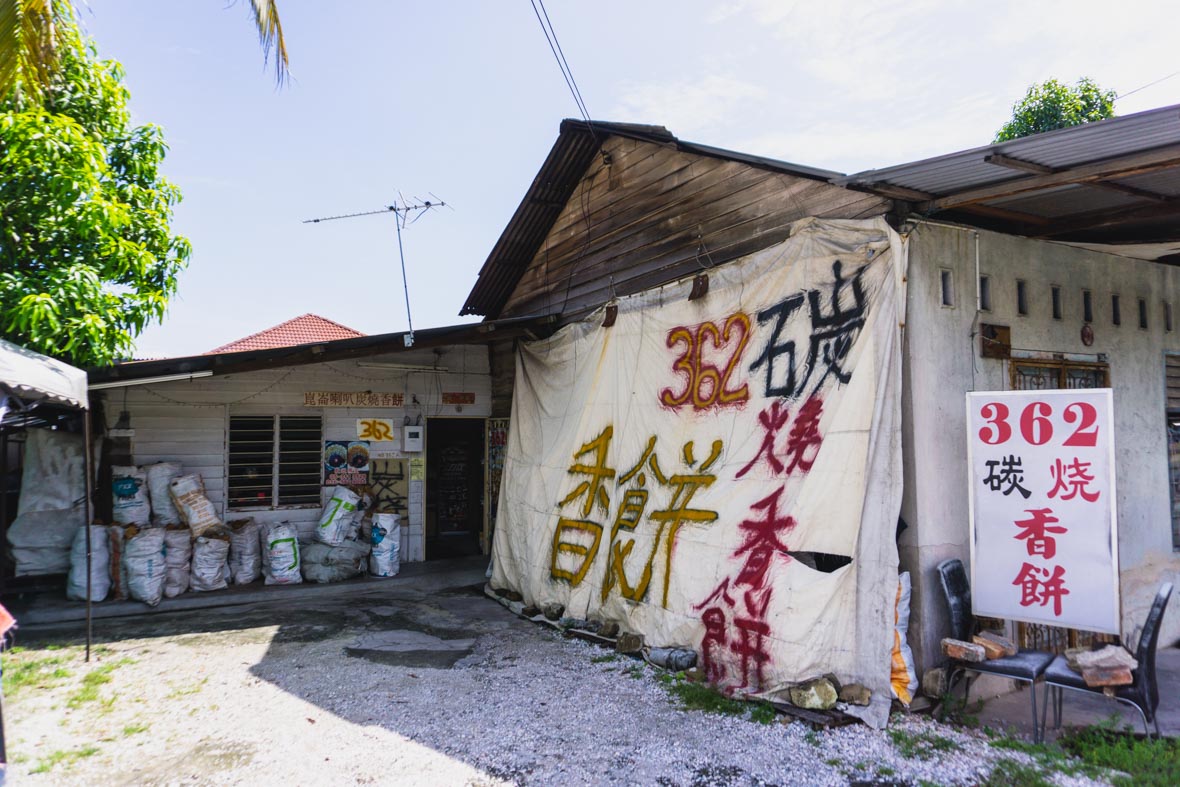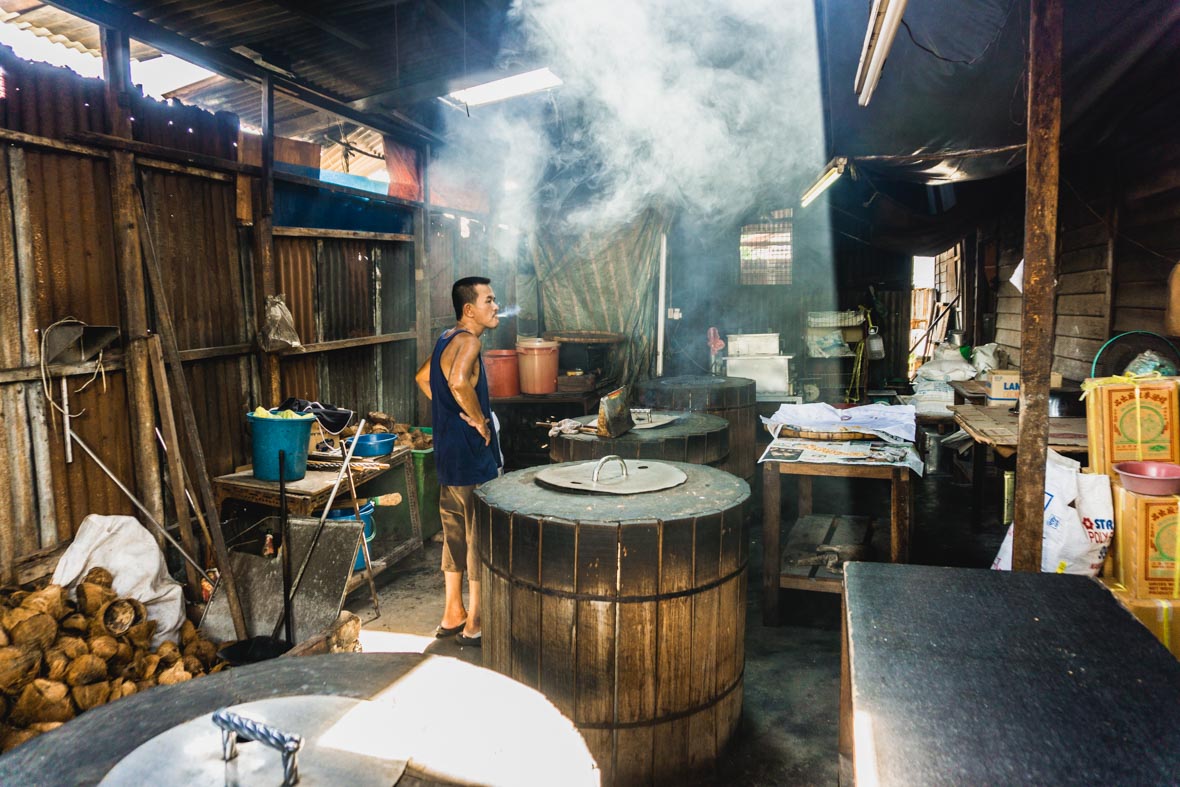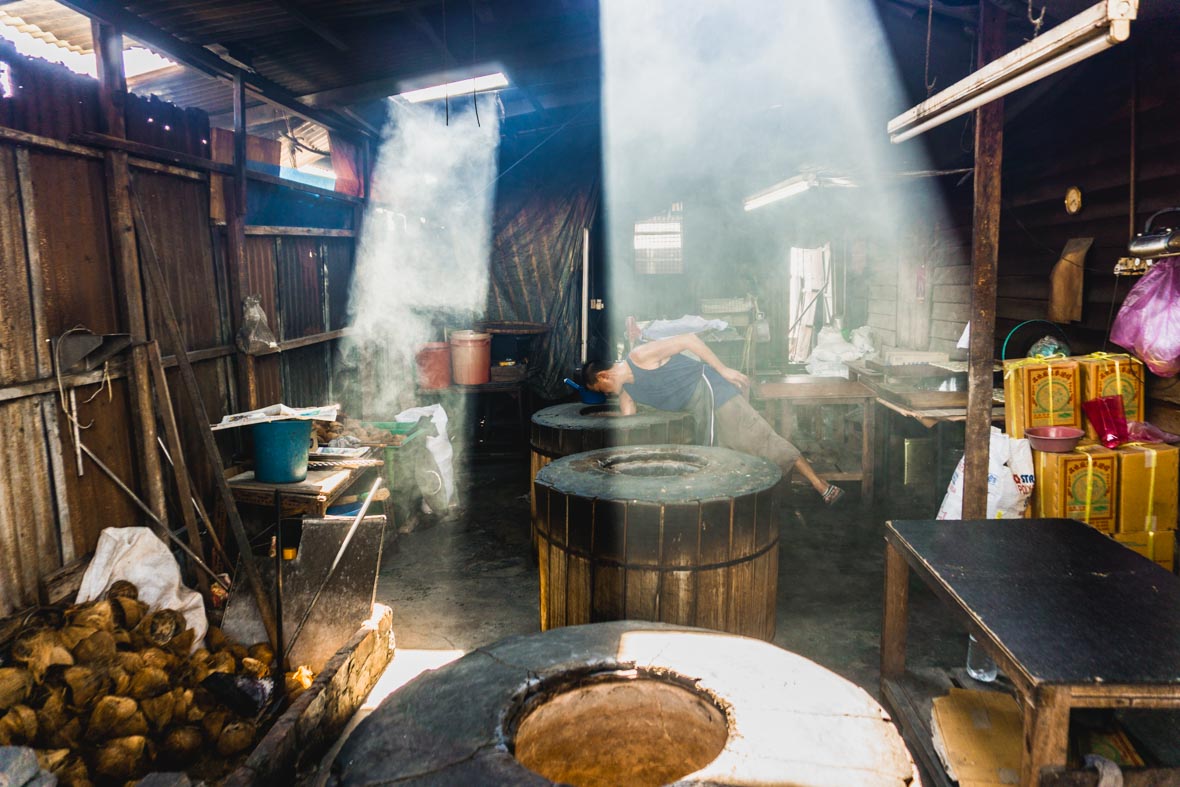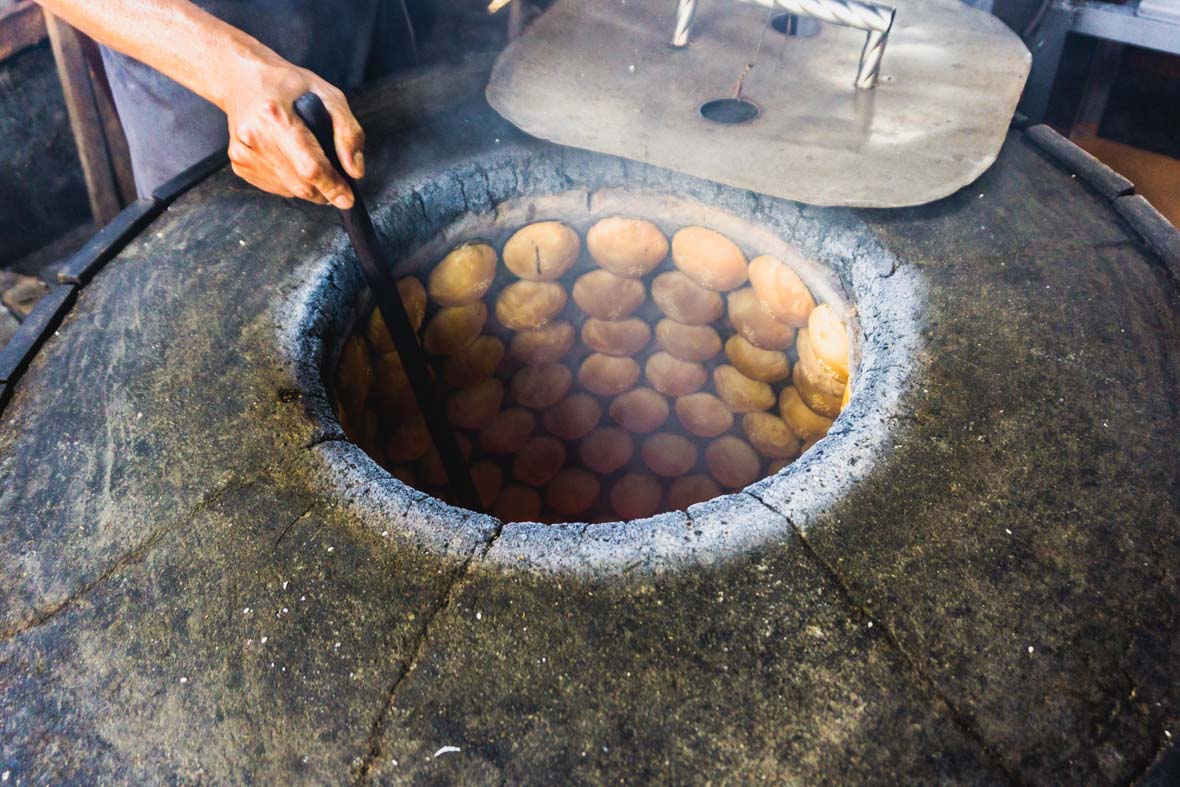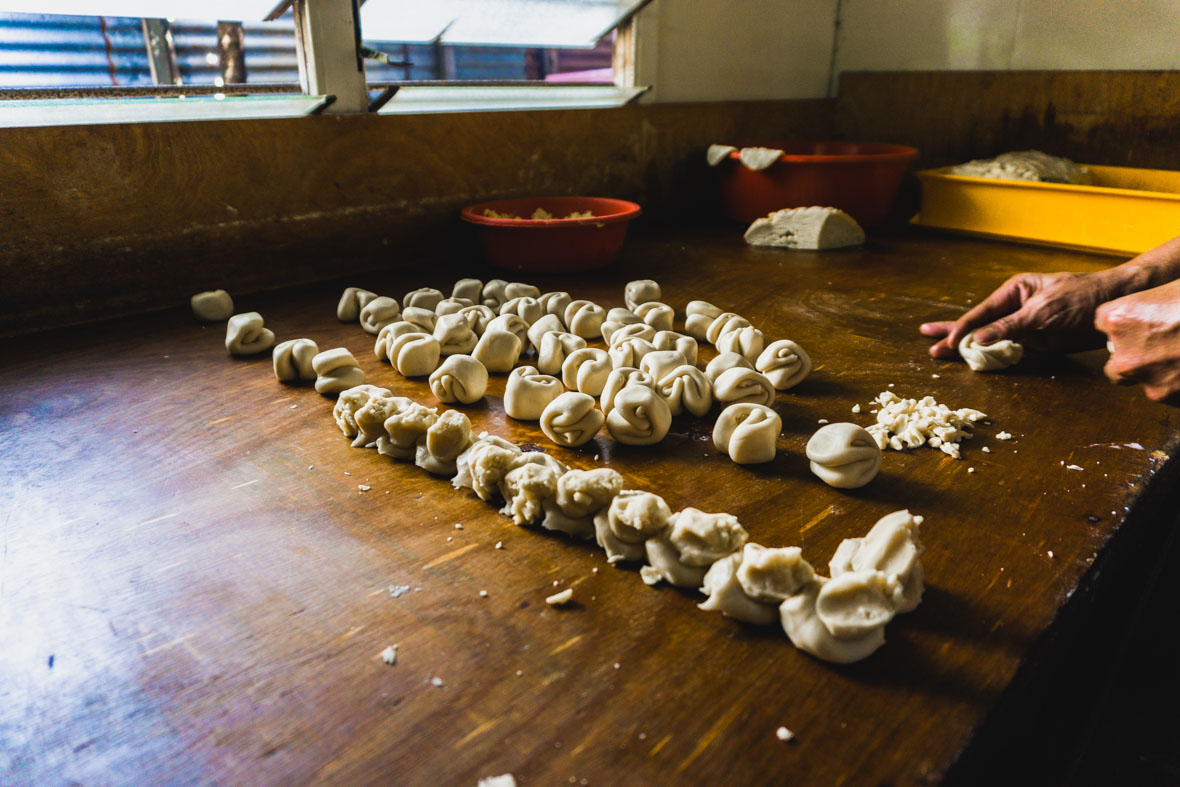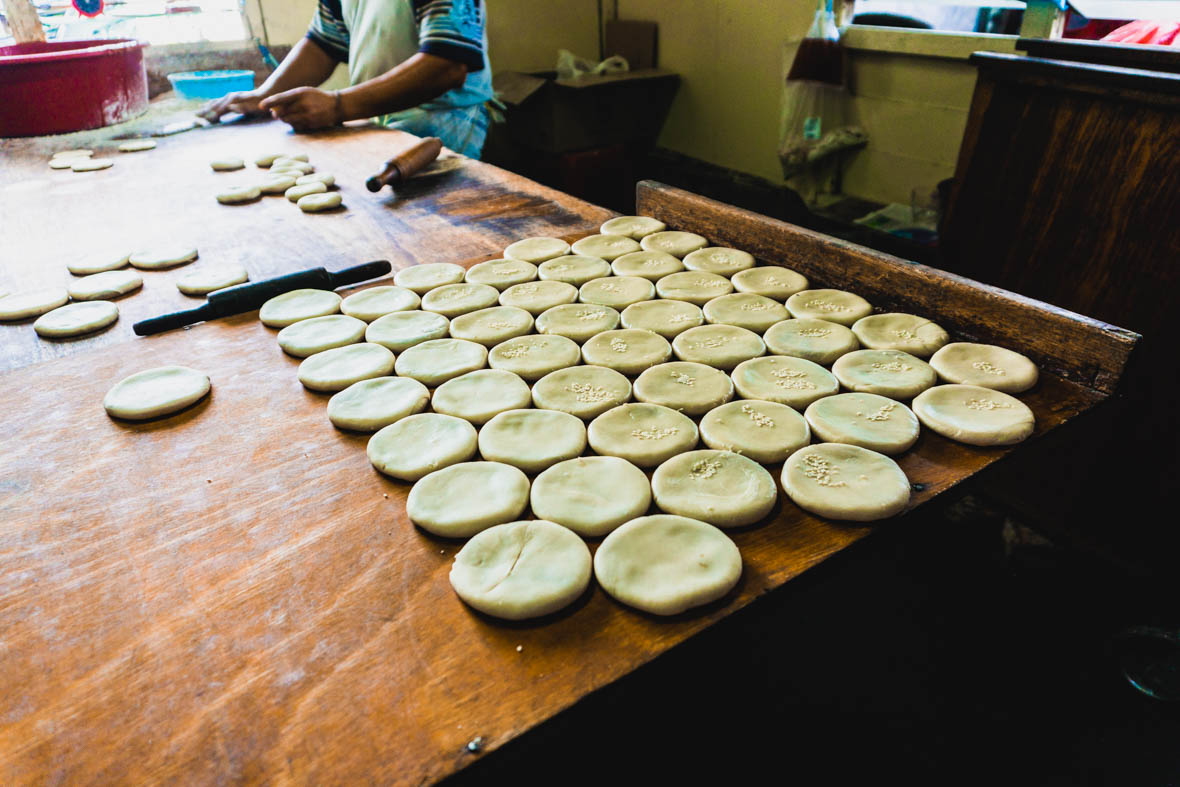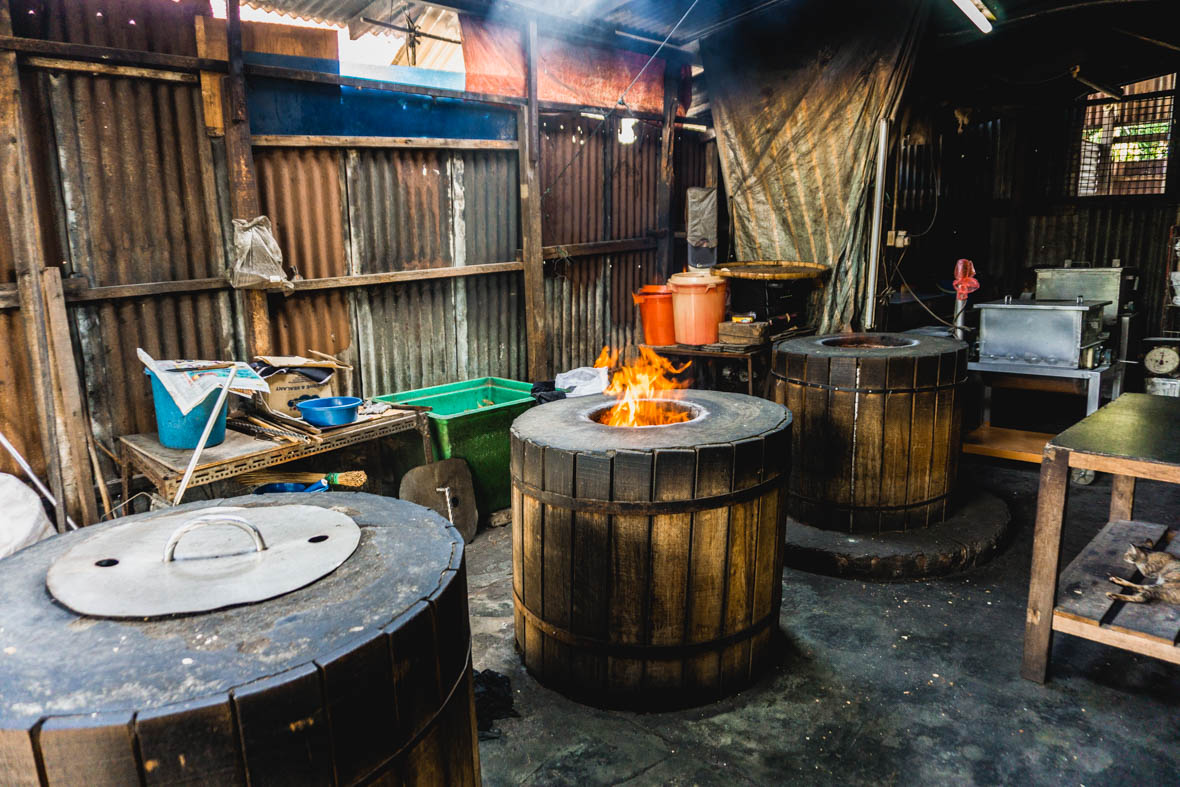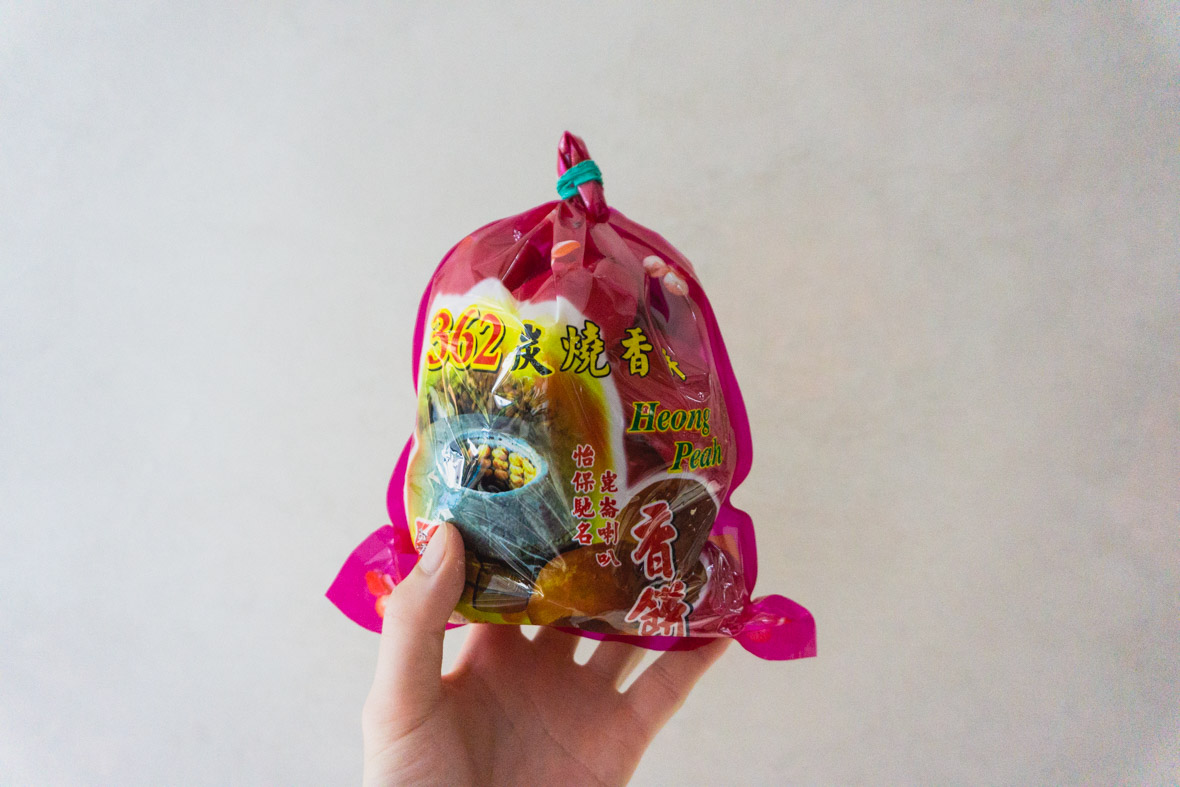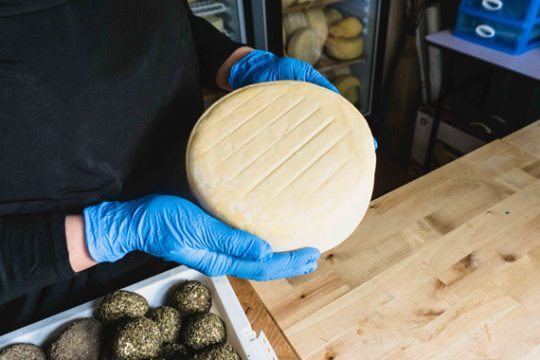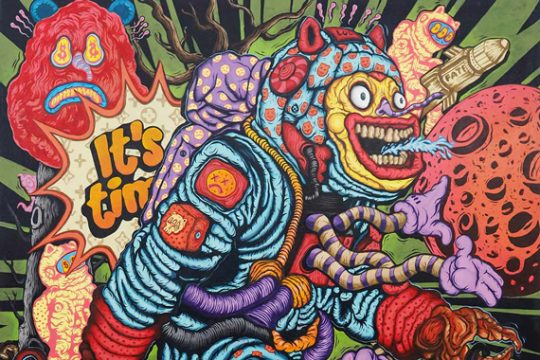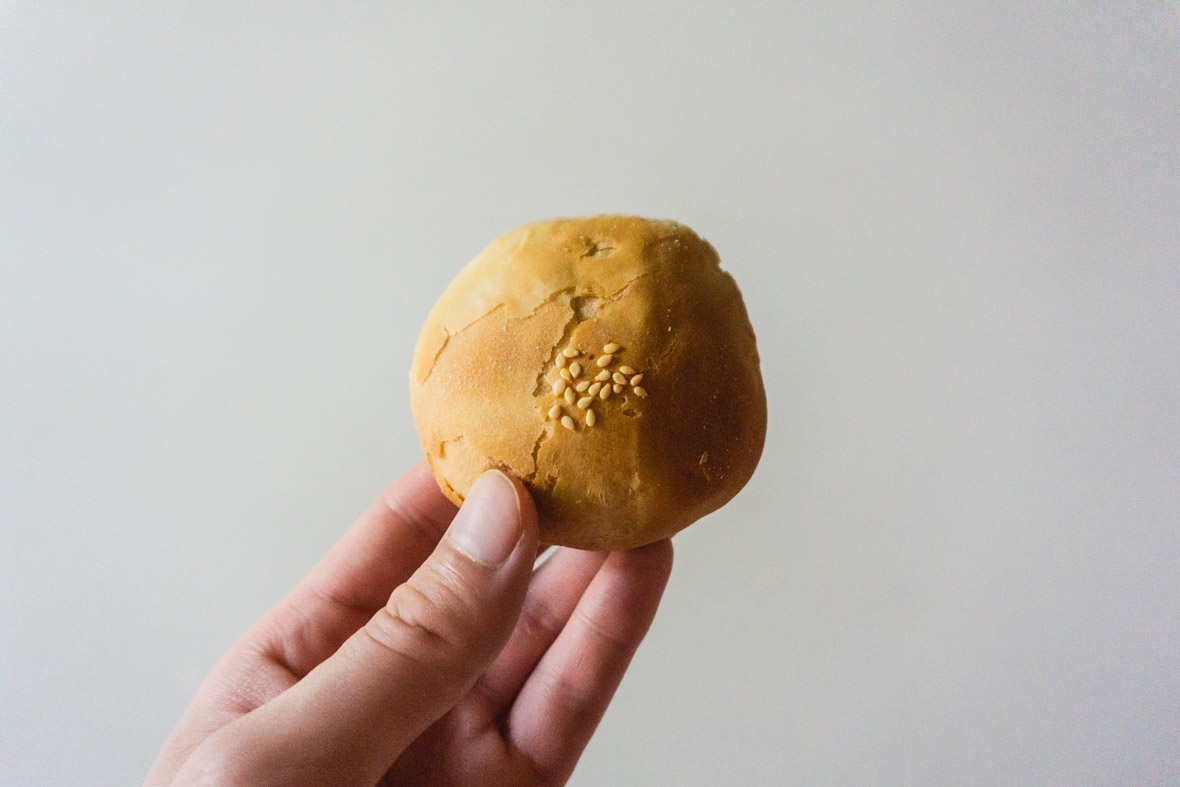
It’s 7 a.m. The sun has barely risen over the sleepy town of Gunung Rapat, but already, Uncle Liow is sweating profusely. His lone figure silhouettes against plumes of smoke snaking out of the four self-made brick furnaces of his ramshackle biscuit workshop-hut, the air heavy with the bittersweet scent of burnt caramel and coconut husk. Around him, rays of light stream down through holes in the makeshift rafters, the chiaroscuro illuminating balls of dough arranged neatly on the table to his side, patiently waiting to be baked off. Uncle Liow shovels more coconut husks into the furnaces, fuelling the growing pyres of flame. Then as the fires subside and the coconut husks turn into perfumed cinder, he takes in a long drag of his cigarette, picks up a dough ball and plunges his hands into the 300°C brick furnace, baking off the first of 1,200 heong peahs for the day.
早上7点。太阳刚刚升起,小镇昆仑喇叭(Gunung Rapat)还万籁俱寂的时候,Uncle Liow已经忙得满头大汗。他孤零零的身影,映衬着四个自制砖炉中飘出的缕缕烟雾,在他这个简陋的饼干工坊里,空气弥漫着焦糖与椰子壳交融那种甜中夹苦的浓郁气味。在他的四周,一束束阳光从临时搭建的屋椽间投射下来,照在他身旁桌子上整齐排列的面团,形成或明或暗的光影变化,这些面团接下来就要被放入砖炉里烤制。Uncle Liow锹更多椰子壳入炉,让火焰燃烧得更旺盛。然后,火势逐渐减弱,椰子壳也烧成了芳香煤渣,这时,他深深抽了一口烟,拿起面团,徒手把面团放入300°C高温的砖炉中,准备烤制今天头1200个香饼(heong peah)。
Though biscuit shops and confectionaries aren’t all that uncommon in Malaysia (after all, the neighbouring city of Ipoh is well known for its egg tarts, kaya puff biscuits, and lotus paste buns), Uncle Liow’s workshop makes, and have only ever made, one particular type of biscuit – the legendary heong peah, which literally means fragrant pastry in Hokkien. They’re flaky, delectable puff biscuits filled with oozing, sinfully thick malted caramel. Its outermost layers are often charred to a deep golden brown, while the caramel inside remains glisteningly moist. It’s akin to a lighter, flakier, Asian version of a Breton Kouign Amann, with a heavier caramel hit.
虽然马来西亚有很多饼家和糖果点心厂家——毕竟,旁边的怡保就是闻名的蛋挞、加央角(kaya puff)和莲蓉饼(lotus paste buns)产地,但Uncle Liow的工作坊只制作一种特定的甜点——著名的香饼。香饼一词来自于闽南语“Heong Peah(芳香糕点)”。薄脆的酥饼内充满浓浓的麦芽焦糖。最外层通常烤成深金黄色,而饼芯则是湿软的焦糖。它就像是亚洲版的布列塔尼特色甜点黄油酥饼(Breton Kouign Amann),但更清淡、更酥脆,焦糖味更浓郁。
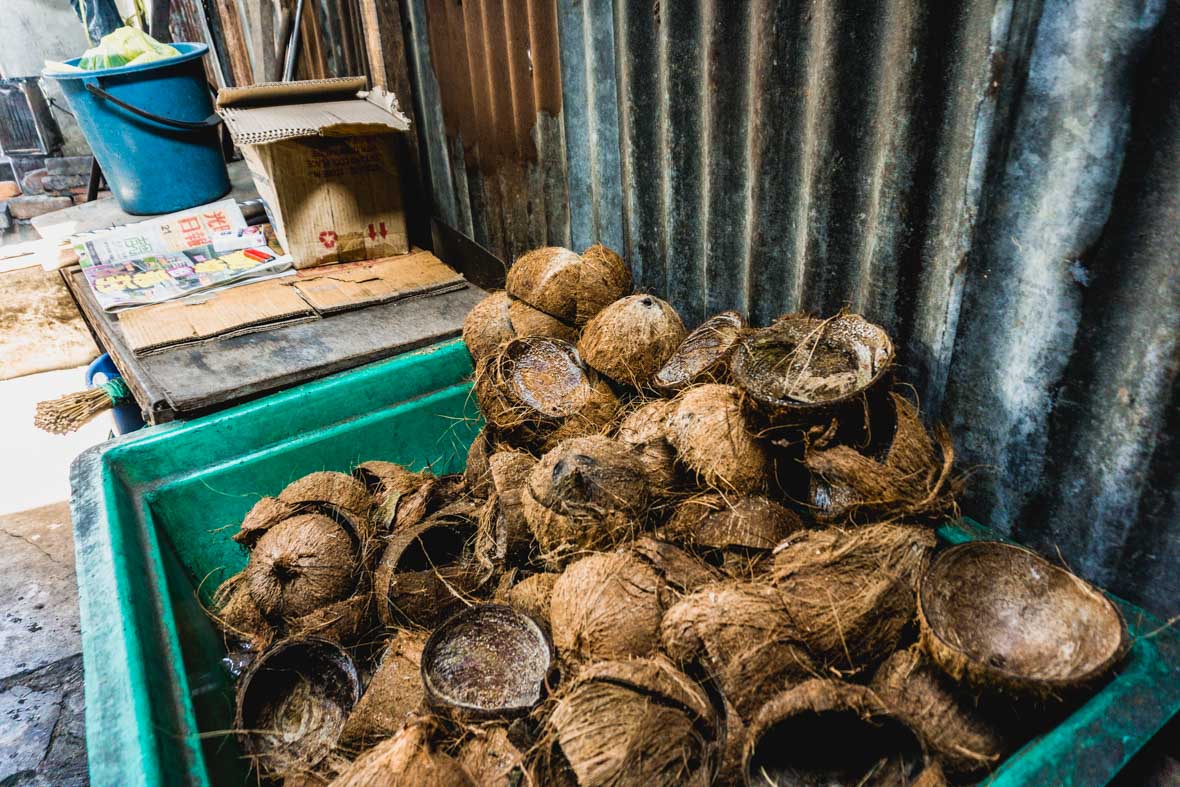
Despite having a Chinese moniker, these biscuits first gained recognition in Malaysia back in 1981 when a second-generation Chinese couple started Yee Hup, a small biscuit workshop based in Gunung Rapat. Yee Hup specialized in heong peah, which until then had only been a niche, sparsely sold biscuit of the region. They developed and improved upon the traditional recipe and baking method, and in less than a decade, their heong peahs gained a cult following throughout Malaysia. Bakers and biscuit-makers around the region soon joined them, wanting to learn their ways of biscuit making. Soon after, with Yee Hup’s growing popularity came the desire to scale up production, but with the traditional methods requiring much effort and manpower, they eventually turned to mechanization and moved to a large-scale factory setting.
尽管有一个中文名字,但香饼一开始在马来西亚家喻户晓得归功于1981年一对第二代移民的中国夫妇所创立的余合饼家(Yee Hup)。余合是一家位于昆仑喇叭的饼家,以制香饼(Heong Peah)为主,同时也会制作当地特色饼糕甜点。在此之前,香饼一直是很小众的甜点。他们在传统秘方和烘烤方法的基础上进行研发和改进,在不到十年时间里,使之成为马来西亚各地广受欢迎的美食。附近的面包和饼干制造商很快就加入了他们,想要学习他们的饼干制作方法。不久之后,余合越来越受欢迎,也有了扩大规模生产的想法,但传统的制作方法需要投入很多功夫和人力,他们最终选择机械化,搬到一个大型工厂进行生产。
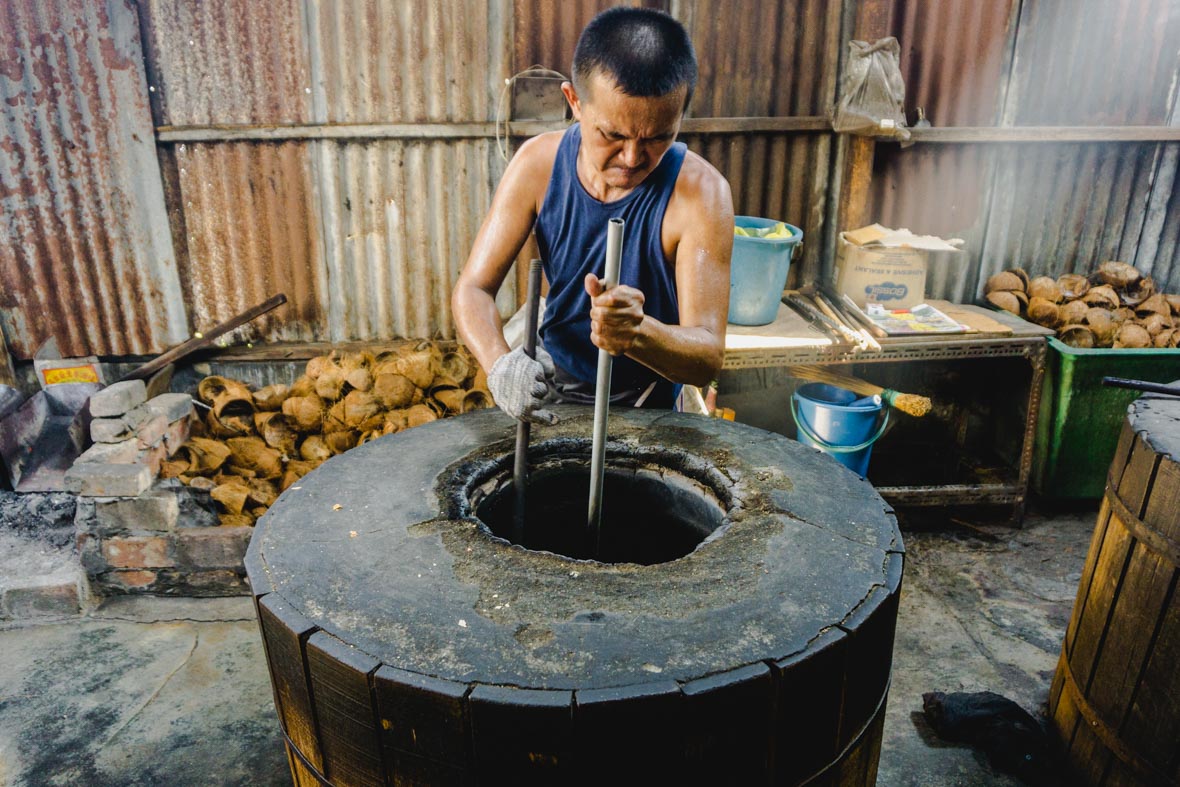
Uncle Liow was one of Yee Hup’s very first workers, and after many years of toil, he rose up the ranks to become one of their stalwart bakers. But when Yee Hup upscaled their business, he parted ways with the company as he wanted to preserve the artisanal methods of biscuit-making. And today, despite having labored over heong peahs for over 30 years, he remains true to his belief, never once faltering and submitting to the less-laborious, profit-driven modern methods of biscuit production. According to Uncle Liow, to get the truest, best-tasting heong peahs, two things are needed – a searing hot furnace fueled with coconut husks for that musky aroma and char, and more importantly, solid technique, which he clearly has a wealth of.
Uncle Liow是余合饼家(Yee Hup)第一批工人之一,经过多年的辛劳工作,他逐渐成为了店里的资深饼糕师傅之一。然而,当余合饼家扩大业务后,他选择了与公司分道扬镳,因为他想保持传统的手工饼糕制作方法。如今,他已经制作香饼30多年,但他仍然坚持着自己的信念,从来没有选择那些更省功夫、更赚钱的现代机器来制饼。Uncle Liow说,要做出最正宗、最美味的香饼,有两件必须品——灼热的烤炉,并且要用椰子壳来生火,因为可以有麝香香气和焦香气味;更重要的是,要有过硬的制作技艺,这一点他显然不缺。
Watching him work is truly mesmerizing. To make the heong peahs, Uncle Liow braves the 300°C heat of the cylindrical brick furnaces, sticking each piece of dough to the searing hot furnace walls in one deft movement. All the while, the hissing flame at the very bottom of the furnace licks at his fingertips, vaporizing the sweat on his hairless, burn-scarred arms. He works in a trance-like state, dancing around the furnace. His brows are furrowed; his hands in and out of the fire with fluid speed and purpose, stopping only to wipe away the beads of sweat collecting on his temples. His focus is palpably intense, as any slip-up would immediately result in painful third-degree burns. Only when every inch of the inner walls of the furnace has been filled with heong pPeahs does he allow himself breathe and take in a few drags of his cigarette as they bake off. Barely ten minutes later though, he is back at it again, this time with a scraper in hand to pry the biscuits off the furnace walls and onto cooling trays, ready to be checked for quality, packaged, and sold.
看着他工作很引人入胜。制作香饼时,Uncle Liow无惧于圆柱形砖炉300°C的高温,迅速将一块块面团放入灼热的炉壁上。砖炉底部的嘶嘶火焰舔着他的指尖,蒸发掉他光滑、布满烧伤伤痕的胳膊上。工作的时候,他仿佛置身另一个世界,变成一名在砖炉上跳舞的舞者。他的眉头紧皱,除了拭去额角上的汗珠,他的双手一直在快速、准确地伸入、抽出砖炉。他如此的专注,因为任何的疏忽都可能会导致三级烧伤的痛苦后果。只有当每一寸炉壁都摆满了香饼后,他才会停下来休息一下,抽口烟,等待香饼烤熟。不到十分钟,他又要回到砖炉前,这一次他手中拿着一把刮刀,把香饼从炉壁上取出,放到冷却托盘上,然后检查香饼的质量,进行打包和出售。
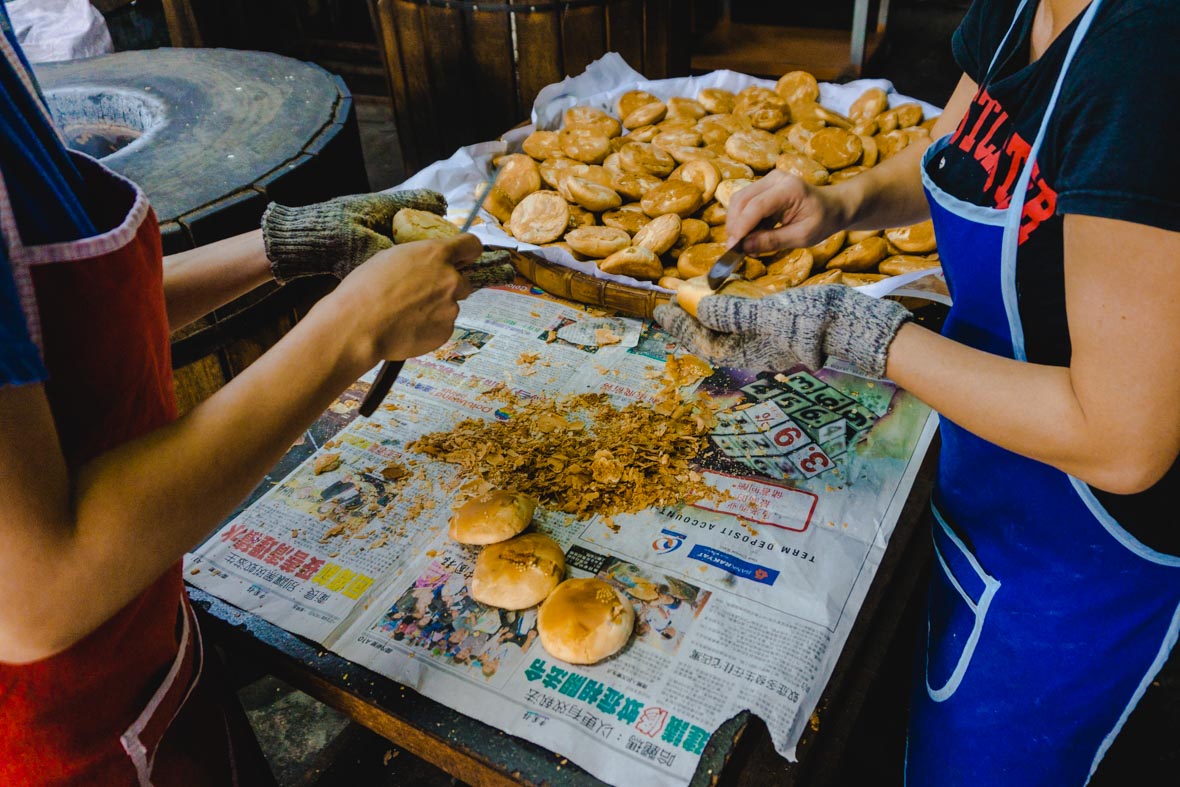
Together, with his team of five employees who helps him in making, filling, and packaging the biscuits, they bake off thousands of heong peahs every day in his humble workshop. They work tirelessly 12 hours a day, six days a week, which is admirable, to say the least, given the intensity and laboriousness of this artisanal business. However, Uncle Liow’s diligence and dedication have definitely paid off, as his workshop (362 Heong Peah) has over the years become a stand-out among the slew of biscuit shops and confectionaries in the area, garnering many loyal customers who travel from all over the country just to get his freshly baked biscuits.
在他的这间制饼工坊里,他和团队里的五名员工一起配制、装馅和包装饼干,每天烤制数千个香饼。他们每天不知疲倦地工作12小时,一周工作六天,鉴于这份工作的强度和辛苦,实在是令人钦佩。然而,Uncle Liow的勤奋和专注显然得到了回报,因为他的制饼工坊“362 张记炭烧香饼”经历多年努力,如今已经成为当地著名的品牌,赢得许多忠诚的顾客,甚至有许多人专程从马来西亚的其它地方过来,只为了能吃到他新鲜烤制的饼糕点心。
Although Uncle Liow’s heong peah business has continued to thrive over the years, other artisanal biscuit-makers have not been as successful, either succumbing to the ever-growing pressure to turn to modern, less laborious methods or having to close down their businesses due to old age and the laboriousness of the process. Thus, 362 Heong Peah now remains one of the few, if not the only artisanal heong peah workshops left in Malaysia, which reflects the unfortunate ravages of mechanization on the humble artisanal biscuit trade. However, despite the current state of the industry, Uncle Liow remains loyal to his mantra that flavor is king, and as such, he believes there will soon be a new wave of young artisans to take up the mantle of reviving and elevating the near-lost art of handmade heong peahs.
虽然Uncle Liow的香饼生意还在不断发展,但很多其它手工饼干制造商却没有他这么成功。他们要么屈服于不断增长的压力,转向现代化、省力的制作工艺,要么不得不因为年纪大了、制作过程太辛苦而选择结业。因此,362 张记炭烧香饼现在仍然是马来西亚为数不多的手工制饼工坊之一,这也反映出机械自动化对手工制饼行业的冲击。然而,虽然行业当前状态不容乐观,但Uncle Liow仍然忠于他的口头禅——好的味道才能成为最终的赢家,因此,他相信,很快会有新一代的年轻制饼师傅,承担起振兴和提升手工香饼制作这一门即将失传的艺术。
Address:
362, Jalan Gunung Rapat
Taman Rapat Setia, 31350 Ipoh
Perak, Malaysia
Tel: +6053113529
Instagram: ~/explore/locations
Contributor: Yi Jun Loh
地址:
362, Jalan Gunung Rapat
Taman Rapat Setia, 31350 Ipoh
Perak, Malaysia
电话: +6053113529
Instagram: ~/explore/locations
供稿人: Yi Jun Loh

